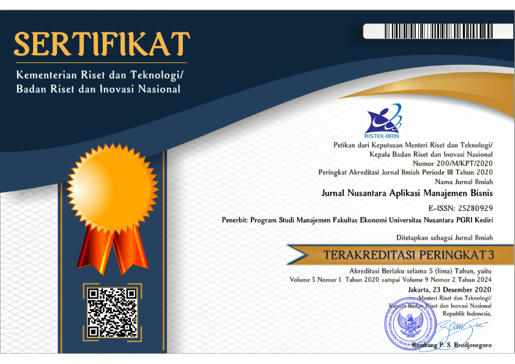SERVQUAL Model Dalam Memulihkan Kepuasan Mahasiswa Politeknik di Kota Medan pada Post Pandemic World
DOI:
https://doi.org/10.29407/nusamba.v10i2.21321Keywords:
SERVQUAL, Student Satisfaction, FacilityAbstract
Research Aim: This study aims to develop a SERVQUAL model to restore student satisfaction in polytechnic institutions in Medan City through campus facilities in the post-pandemic period.
Approach: The research uses a quantitative approach with descriptive statistical analysis and Structural Equation Modeling–Partial Least Squares (SEM-PLS). Data were collected from polytechnic students in Medan City using purposive sampling techniques.
Research Finding: The results indicate that SERVQUAL significantly influences polytechnic student satisfaction through campus facilities in the post-pandemic era. The quality dimensions of tangibility, reliability, responsiveness, assurance, and empathy contribute to improving overall satisfaction.
Theoretical Contribution/Originality: This study extends the application of the SERVQUAL model in higher education by integrating post-pandemic contextual factors, offering new insights into the determinants of student satisfaction in vocational institutions.
Practitioner/Policy Implication: Findings provide practical implications for educational managers to enhance academic service quality and campus facilities, thereby improving educational competitiveness and institutional reputation after the pandemic.
Research Limitation: This study is limited to polytechnic institutions in Medan City, so future research should include broader geographic coverage and comparative analysis across various higher education institutions.
Downloads
References
[1] F. Marnilin, I. Mutmainah, and I. A. Yulia, “Pengaruh Perceived Value Terhadap Kepuasan Implementasi Program MBKM,” J. Ilm. Manaj. Kesatuan, vol. 11, no. 1, pp. 1–10, 2023, doi: 10.37641/jimkes.v11i1.936.
[2] P. P. Sentosa, N. M. E. O. Astuti, and I. M. E. Cahaya, “Analisis kepuasan mahasiswa menggunakan metode servqual,” Media Edukasi, vol. 3, no. 2, pp. 85–96, 2019.
[3] UNESCO, “Education in a post-COVID world : nine ideas for public action,” Int. Comm. Futur. Educ., p. 26, 2020, [Online]. Available: https://en.unesco.org/news/education-post-covid-world-nine-ideas-public-action
[4] Y. Prananda, D. R. Lucitasari, and M. S. Abdul Khannan, “Penerapan Metode Service Quality (Servqual) Untuk Peningkatan Kualitas Pelayanan Pelanggan,” Opsi, vol. 12, no. 1, p. 1, 2019, doi: 10.31315/opsi.v12i1.2827.
[5] S. Aulia and S. Djuarsa, “Pengaruh Service Quality Terhadap Kepuasan Dan Word of,” Semin. Nas. Cendekiawan 2015, pp. 46–52, 2015.
[6] S. D. Rachmawati and A. L. Andjarwati, “Pengaruh Kesadaran Merek dan Citra Merek Terhadap Keputusan Pembelian ( Studi pada Pengguna JNE Express di Surabaya Selatan ) ( The Effect of Brand Awareness and Brand Image on Purchasing Decisions ( Study of JNE Express Users in South Surabaya )),” e-Journal Ekon. Bisnis dan Akunt., vol. VII, no. 1, pp. 25–29, 2020.
[7] I. Ghozali and H. Latan, Partial Least Square: Konsep, Teknik, dan Aplikasi Menggunakan Program SmartPLS 3.0, 2nd ed. Semarang: Badan Penerbit Universitas Diponegoro, 2015.
[8] J. F. Hair, J. J. Risher, M. Sarstedt, and C. M. Ringle, “When to use and how to report the results of PLS-SEM,” Eur. Bus. Rev., vol. 31, no. 1, pp. 2–24, 2019, doi: 10.1108/EBR-11-2018-0203.
[9] J. F. Hair, J. J. Risher, M. Sarstedt, and C. M. Ringle, “When to use and how to report the results of PLS-SEM,” Eur. Bus. Rev., vol. 31, no. 1, pp. 2–24, 2019, doi: 10.1108/EBR-11-2018-0203.
[10] M. J. Lachowicz, K. J. Preacher, and K. Kelley, “A novel measure of effect size for mediation analysis,” Psychol. Methods, vol. 23, no. 2, pp. 244–261, 2018, doi: 10.1037/met0000165.
[11] S. Ogbeibu and J. Gaskin, “Back from the Future: Mediation and Prediction of Events Uncertainty through Event-Driven Models (EDMs),” FIIB Bus. Rev., vol. 12, no. 1, pp. 10–19, 2023, doi: 10.1177/23197145221121084.
[12] Padli, A. Pebrianto(, and Rustaniah, “KEPUASAN MAHASISWA TERHADAP PELAYANAN ADMINISTRASI AKADEMIK PADA JURUSAN ADMINISTRASI BISNIS POLITEKNIK NEGERI BANJARMASIN,” J. INTEKNA, vol. 19, no. 1, pp. 15–20, 2019.
[13] E. R. Nofrida and K. H. Najib, “Analisis Pengaruh Kualitas Layanan Akademik Terhadap Kepuasan Mahasiswa,” J. Manaj. Pendidik. Dasar, Menengah dan Tinggi [JMP-DMT], vol. 4, no. 4, pp. 472–483, 2023, doi: 10.30596/jmp-dmt.v4i4.16231.
[14] H. Huwaida, Rofi’i, and S. Imelda, “Pengaruh Kualitas Pelayanan Pendidikan Terhadap Kepuasan Mahasiswa Di Jurusan Administrasi Bisnis Politeknik Negeri Banjarmasin,” J. INTEKNA, vol. 18, no. 2, pp. 67–131, 2018.
[15] Ermini, D. S. Nindiati, and M. Kurniawan, “Analisis Kepuasan Mahasiswa FKIP Atas Kualitas Layanan Akademik,” J. Media Wahana Ekon., vol. 18, no. 4, pp. 468–481, 2022, [Online]. Available: https://jurnal.univpgri-palembang.ac.id/index.php/Ekonomika/index
[16] T. V. Ardana, M. D. Lestari, R. Rahardi, P. Aggim, and V. F. Sanjaya, “Pengaruh Fasilitas Terhadap Kepuasan Mahasiswa Fakultas Ekonomi dan Bisnis UIN Lampung,” Glob. J. Lentera BITEP, vol. 1, no. 03, pp. 111–117, 2023, doi: 10.59422/global.v1i03.153.
[17] N. Nofriavani, W. Muhammad, Z. Muhammad, and K. Rifqil, “PENGARUH KUALITAS PELAYANAN DAN FASILITAS KAMPUS Lembaga Pendidikan Perguruan Tinggi Institut Teknologi dan Bisnis Master,” J. Islam. Econ. Manag. Bus., vol. 1, no. 1, pp. 29–43, 2022.
[18] A. Hidayati, A. N. Mauliza, A. Satria, and V. F. Sanjaya, “Pengaruh Fasilitas Dan Kondisi Lingkungan Terhadap Kepuasan Mahasiswa,” J. Manaj. Dan Bisnis, vol. 2, no. 2, pp. 173–189, 2023, doi: 10.36490/jmdb.v2i2.989.
[19] P. P. Sentosa, N. M. E. O. Astuti, and I. M. E. Cahaya, “Analisis Kepuasan Mahasiswa Menggunakan Metode Servqual,” Media Edukasi, vol. 3, no. 2, pp. 85–96, 2019, [Online]. Available: https://jurnal.undhirabali.ac.id/index.php/jmk/article/view/1033/929
Downloads
Published
Issue
Section
License
Copyright (c) 2025 Ngajudin Nugroho, Elserra Siemin Ciamas, Fauzi Akbar Maulana Hutabarat

This work is licensed under a Creative Commons Attribution-ShareAlike 4.0 International License.
Authors who publish with this journal agree to the following terms:
- Copyright on any article is retained by the author(s).
- The author grants the journal, the right of first publication with the work simultaneously licensed under a Creative Commons Attribution License that allows others to share the work with an acknowledgment of the work’s authorship and initial publication in this journal.
- Authors are able to enter into separate, additional contractual arrangements for the non-exclusive distribution of the journal’s published version of the work (e.g., post it to an institutional repository or publish it in a book), with an acknowledgment of its initial publication in this journal.
- Authors are permitted and encouraged to post their work online (e.g., in institutional repositories or on their website) prior to and during the submission process, as it can lead to productive exchanges, as well as earlier and greater citation of published work.
- The article and any associated published material is distributed under the Creative Commons Attribution-ShareAlike 4.0 International License












